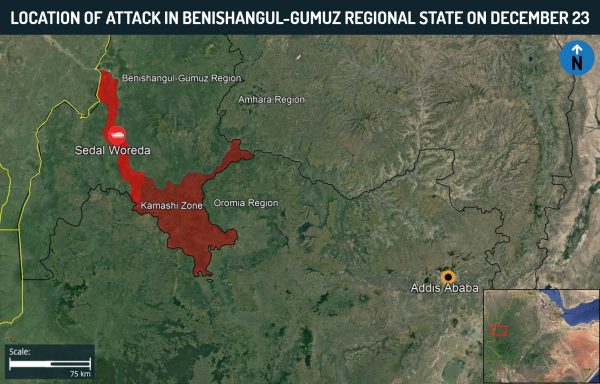23
Apr 2021
10:49 UTC
Ethiopia Alert: Armed group take control of Diza, possible control of other locations in Sedal Woreda, Kamashi Zone, Benishangul-Gumuz Regional State as reported on April 22
Please be advised
- Sources quoting Benishangul Gumuz’s deputy commissioner of police indicate that armed men affiliated with an unnamed ethnic Gumuz militia have taken control of Diza Town in Sedal Woreda as of April 22. The group reportedly conducted an attack in a location called Mersho within the same administrative area, killing at least four people, including one police commander and three civilians.
- The source indicated that the armed men had come from the neighboring Metekel Zone, adding that regional forces were not sufficient to counter the group’s offenses, forcing many residents, as well as police and government officials to flee the area.
- According to a post published by the Ethiopian Human rights Commission (EHRC) on social media, the group claims to have received reports that an armed group had taken nearly full control of Sedal Woreda in Kamashi Zone as of April 19, adding that regional forces had been outnumbered by the dissident forces.
- The EHRC post also stated that the group had killed several civilians and abducted public servants during attacks.
Assessments & Forecast
- While the exact identity of the militia group remains unclear, the recent attacks come amid a notable escalation in intercommunal violence and armed conflict in Benishangul Gumuz Region since 2020. This violence has been driven by the activity of ethnic Gumuz militia groups who have been repeatedly accused of inciting communal tensions over perceptions of immigrants from the Amhara Region occupying land traditionally belonging to ethnic Gumuz groups.
- These latest developments are extremely notable given that the group has reportedly taken control of the localities in Sedal Woreda, which marks a departure from the observed modus operandi of militia groups conducting attacks and raids and withdrawing subsequently. In this instance, given that government sources often tend to understate gains of militia and other dissident groups, there exists the possibility of the group exerting control over more localities than just Diza.
- The neighboring Metekel Zone has represented a focal point for regional insecurity over ethnic tensions, which have persisted despite the deployment of federal military and security personnel to the zone. In this context, given the possible linkage between the perpetrators and other ethnic Gumuz militia suspected of carrying out attacks in Metekel Zone, it is plausible that the group sought to exert authority amid a security vacuum in localities around Metekel, where regional forces are relatively short-staffed.
- FORECAST: Given the reported departure of security forces and government officials in the area, public services are liable to remain disrupted for an extended period until security forces are able to restore government authority across the locality. Given the situation, the government can be expected to reinforce positions across Sedal Woreda, which is likely to include deployments of federal military forces as well to reinforce regional forces. This is likely to include movement restrictions in and out of the woreda as well as increased checkpoints across the Kamashi Zone as well.
- FORECAST: It is unlikely that the ethnic militia has acquired the capability to retain control over the locality over an extended period. This increases the likelihood of calm being restored to the locality following the anticipated arrival of reinforcements. However, it is possible that any redeployment of forces from other sensitive zones such as the Metekel Zone could heighten vulnerability in those localities, especially given the entrenched insecurity in the region.
- More broadly, the escalating violence is further liable to further heighten ethnic tensions between ethnic Gumuz and ethnic Amhara, as well as other minority communities in the region. FORECAST: Given that inter-communal relations remain volatile in Kamashi Zone, the incident could embolden other ethnic militia operating in the region to also attempt to take over vulnerable woredas over the coming months. Locally, this volatile security environment is also likely to heighten anti-government sentiment, especially targeted against the Ethiopian Prosperity Party (EPP) over the federal government’s insufficient security response. Furthermore, the insecurity is likely to strain humanitarian relief operations over an expected surge in IDPs in the region.
Recommendations
- Travel to Addis Ababa may continue while maintaining heightened vigilance in crowded areas due to the high risks of non-violent personal property crime.
- Those operating or residing in Benishangul-Gumuz Region’s Kamashi Zone are advised to maintain heightened vigilance over the coming days and be prepared to comply with additional or sudden security measures and checkpoints.
COUNTRY RISK LEVEL
High
AFFECTED AREA
Sedal Woreda, Kamashi Zone, Benishangul-Gumuz Regional State
INCIDENT RISK LEVEL
High
STRENGTH OF SOURCE
Credible
Please be advised
- Sources quoting Benishangul Gumuz’s deputy commissioner of police indicate that armed men affiliated with an unnamed ethnic Gumuz militia have taken control of Diza Town in Sedal Woreda as of April 22. The group reportedly conducted an attack in a location called Mersho within the same administrative area, killing at least four people, including one police commander and three civilians.
- The source indicated that the armed men had come from the neighboring Metekel Zone, adding that regional forces were not sufficient to counter the group’s offenses, forcing many residents, as well as police and government officials to flee the area.
- According to a post published by the Ethiopian Human rights Commission (EHRC) on social media, the group claims to have received reports that an armed group had taken nearly full control of Sedal Woreda in Kamashi Zone as of April 19, adding that regional forces had been outnumbered by the dissident forces.
- The EHRC post also stated that the group had killed several civilians and abducted public servants during attacks.
Assessments & Forecast
- While the exact identity of the militia group remains unclear, the recent attacks come amid a notable escalation in intercommunal violence and armed conflict in Benishangul Gumuz Region since 2020. This violence has been driven by the activity of ethnic Gumuz militia groups who have been repeatedly accused of inciting communal tensions over perceptions of immigrants from the Amhara Region occupying land traditionally belonging to ethnic Gumuz groups.
- These latest developments are extremely notable given that the group has reportedly taken control of the localities in Sedal Woreda, which marks a departure from the observed modus operandi of militia groups conducting attacks and raids and withdrawing subsequently. In this instance, given that government sources often tend to understate gains of militia and other dissident groups, there exists the possibility of the group exerting control over more localities than just Diza.
- The neighboring Metekel Zone has represented a focal point for regional insecurity over ethnic tensions, which have persisted despite the deployment of federal military and security personnel to the zone. In this context, given the possible linkage between the perpetrators and other ethnic Gumuz militia suspected of carrying out attacks in Metekel Zone, it is plausible that the group sought to exert authority amid a security vacuum in localities around Metekel, where regional forces are relatively short-staffed.
- FORECAST: Given the reported departure of security forces and government officials in the area, public services are liable to remain disrupted for an extended period until security forces are able to restore government authority across the locality. Given the situation, the government can be expected to reinforce positions across Sedal Woreda, which is likely to include deployments of federal military forces as well to reinforce regional forces. This is likely to include movement restrictions in and out of the woreda as well as increased checkpoints across the Kamashi Zone as well.
- FORECAST: It is unlikely that the ethnic militia has acquired the capability to retain control over the locality over an extended period. This increases the likelihood of calm being restored to the locality following the anticipated arrival of reinforcements. However, it is possible that any redeployment of forces from other sensitive zones such as the Metekel Zone could heighten vulnerability in those localities, especially given the entrenched insecurity in the region.
- More broadly, the escalating violence is further liable to further heighten ethnic tensions between ethnic Gumuz and ethnic Amhara, as well as other minority communities in the region. FORECAST: Given that inter-communal relations remain volatile in Kamashi Zone, the incident could embolden other ethnic militia operating in the region to also attempt to take over vulnerable woredas over the coming months. Locally, this volatile security environment is also likely to heighten anti-government sentiment, especially targeted against the Ethiopian Prosperity Party (EPP) over the federal government’s insufficient security response. Furthermore, the insecurity is likely to strain humanitarian relief operations over an expected surge in IDPs in the region.
Recommendations
- Travel to Addis Ababa may continue while maintaining heightened vigilance in crowded areas due to the high risks of non-violent personal property crime.
- Those operating or residing in Benishangul-Gumuz Region’s Kamashi Zone are advised to maintain heightened vigilance over the coming days and be prepared to comply with additional or sudden security measures and checkpoints.


